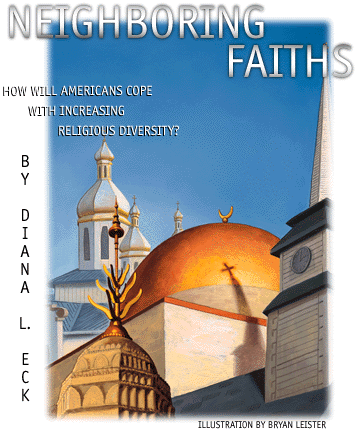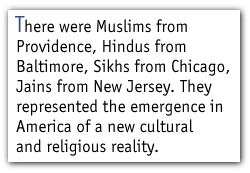Main Menu · Search ·Current Issue ·Contact ·Archives ·Centennial ·Letters to the Editor ·FAQs


I first came to Harvard as a student of the culture and religions
of India. I was fascinated by India's many religious traditions-the interrelations,
tensions, and movements of Hindu, Buddhist, Jain, Muslim, and Sikh traditions
over many centuries in a complex culture. But never did I imagine as I began
teaching here in the late 1970s that the very interests that drew me to
India would lead me in the 1990s to the study of the United States. So how
is it that a scholar of comparative religion and Indian studies has spent
the past five years studying America-furtively at first, fearful to be treading
on the territory of some of Harvard's most distinguished scholars, then
unapologetically, flagrantly, even zealously?
That intellectual passage from India to America began here at Harvard. The
circumstances that drove me to study America raise important issues-for
Harvard, for the United States, and perhaps for the world. They are issues
all of us will encounter in a world shaped by a new geopolitical and a new
"georeligious" reality.
For me, this journey began in the academic year 1989-90. Suddenly the contextual
ground under my own feet as a scholar and teacher began to shift. In the
past, I had always had several students from India in my classes on India,
but in that year, their numbers increased. Only now, they were not from
India, but were Indian Americans, born and raised in San Antonio, Baltimore,
or Cleveland. They were, as I discovered, the children of the first generation
of immigrants who had settled in America after the passage of the 1965 immigration
act. That historic event finally removed the legal legacy of racism that
had been built into immigration legislation from the first Chinese exclusion
act in 1882 to the Johnson Reed Act in 1924, which effectively barred Asian
immigrants for four decades. The 1965 policy opened the door again for immigration
from Asia and from other parts of the world.

As a scholar of India, I had taken note of the effects of the new immigration
on that country, the so-called "brain drain," as thousands of
Indian professionals, doctors, and scientists left India for the United
States. I have to admit, however, that I had never stopped to think what
this would mean for the United States until the children of this first generation
of Indian immigrants reached college age and enrolled in my classes at Harvard
that year. There were Muslims from Providence, Hindus from Baltimore, Sikhs
from Chicago, Jains from New Jersey. They represented the emergence in America
of a new cultural and religious reality.
Some came from very secular families and knew little of their Indian heritage.
Others had grown up in the new Hindu or Muslim culture of temples and Islamic
centers their parents had begun to establish here in the United States.
Some had been to Muslim youth leadership camps, organized by the Islamic
Society of North America. Some had been to a Hindu summer camp at Rajarajeswari
Pitha in the Poconos, or to a family Vedanta camp at Arsha Vidya Gurukulam
in Saylorsburg, Pennsylvania. Some were involved as founding members of
the Jain Youth of North America. Straddling two worlds, critically appropriating
two cultures, they lived in perpetual inner dialogue between the distinctive
cultures of their parents and grandparents and the forceful, multiple currents
of American culture. In their own struggles with identity lay the very issues
that were beginning to torment the soul of the United States.
The new questions that arose were not only those that underlay the foreign
cultures requirement of the Core Curriculum-how we might understand some
"other" civilization so different from our own. Other questions
pushed themselves to the fore: what does it mean to speak of "our own"
culture? Who do "we" mean when we say "we?" How are
"difference" and "otherness" defined, and by whom? The
word "multicultural" signaled the fact that every dimension of
American culture had become more complex. Racial issues became multisided,
with Hispanic and Latino, Korean and Filipino, Chinese and Indian perspectives.
Religious diversity shattered the paradigm of an America the sociologist
Will Herberg had confidently described as a "three religion country"-Protestant,
Catholic, and Jewish. By the 1990s, there were Hindus and Sikhs, Buddhists
and Jains. There were more Muslims than Episcopalians, more Muslims than
Presbyterians, perhaps soon more Muslims than Jews.
The sons and daughters of the first generation from South Asia rose at Harvard
to become some 5 percent of the Harvard undergraduate population. In the
spring of 1993, when that first class graduated, I slipped into the balcony
at Memorial Church for the Baccalaureate service and sat with the families
of Mukesh Prasad and Maitri Chowdhury, the first marshals of the Harvard
and Radcliffe graduating classes that year-both Hindus. Maitri recited a
hymn from the Rig-Veda in ancient Sanskrit. It was a new Harvard. It had
happened in four years.
The Puritans founded Harvard College to provide an educated Christian ministry
for the churches. Before Judah Monis, a Sephardic Jew, was hired to teach
Hebrew in 1722, he publically converted to Christianity. But both Judah
Monis and Cotton Mather would be astounded at Harvard in the 1990s-its Chinese
and Korean Christian fellowships, its diverse and vibrant Jewish community,
its rapidly growing Islamic Society. In December 1994, the newly founded
Harvard Buddhist Community observed the Buddha's Enlightenment Day for the
first time ever at Harvard. There in the Divinity School's Braun Room, beneath
the august portraits of a long lineage of divinity deans, some 50 Harvard
students from a dozen Buddhist lineages sat on rows of square zabutons,
listening to Pali, Tibetan, and Vietnamese chanting and rising, one by one,
to make offerings of incense.
What has happened at Harvard has happened at major universities throughout
the country. In the 1990s, universities have become the microcosms and laboratories
of a new multicultural and multireligious America. It is not uncommon to
have Hindu and Jew, Muslim and Christian in a single rooming group. These
changes in university demographics have come not from abroad, but from the
rapidly changing cultural and religious landscape of the United States.
Harvard's issues, America's issues, have become, increasingly, a fresh recasting
of many of India's issues, the world's issues: race, culture, religion,
difference, diversity, and whether it is possible to move from diversity
to pluralism.
I knew in 1990 that my own teaching context had radically changed and the
scope of my academic work would have to change, too. Increasingly, it became
clear to me that the very shape of traditional fields of study was inadequate
to this new world. In my field, those of us who study Buddhism, Islam, or
Hinduism all earn our academic stripes, so to speak, by intensive study
in Japan, Egypt, or India, doing language studies, textual editions and
translations, fieldwork. And those who study religion in America focus largely
on the Protestant mainstream, or perhaps on Catholics, or American Judaism-but
not on American Buddhism, not on the Muslims of America, not on the Sikhs
of America. And those historians who focus their work on what has become
known as ethnic studies are curiously silent about the religious traditions
of America's ethnic minorities-the old Islamic traditions of the African
slaves, the old Chinese temples in Montana and Idaho, or the early Sikh
communities in California's Imperial Valley.
